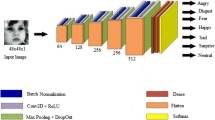Abstract
Facial expression recognition is a challenging problem in image classification. Recently, the use of deep learning is gaining importance in image classification. This has led to increased efforts in solving the problem of facial expression recognition using convolutional neural networks (CNNs). A significant challenge in deep learning is to design a network architecture that is simple and effective. A simple architecture is fast to train and easy to implement. An effective architecture achieves good accuracy on the test data. CNN architectures are black boxes to us. VGGNet, AlexNet and Inception are well-known CNN architectures. These architectures have strongly influenced CNN model designs for new datasets. Almost all CNN models known to achieve high accuracy on facial expression recognition problem are influenced by these architectures. This work tries to overcome this limitation by using FER-2013 dataset as starting point to design new CNN models. In this work, the effect of CNN parameters namely kernel size and number of filters on the classification accuracy is investigated using FER-2013 dataset. Our major contribution is a thorough evaluation of different kernel sizes and number of filters to propose two novel CNN architectures which achieve a human-like accuracy of 65% (Goodfellow et al. in: Neural information processing, Springer, Berlin, pp 117–124, 2013) on FER-2013 dataset. These architectures can serve as a basis for standardization of the base model for the much inquired FER-2013 dataset.




Similar content being viewed by others
References
Goodfellow, I.J., Erhan, D., Carrier, P.L., Courville, A., Mirza, M., Hamner, B., Zhou, Y.: Challenges in representation learning: a report on three machine learning contests. In: Lee, M., Hirose, A., Hou, Z. G., Kil R.M. (eds.) Neural Information Processing, ICONIP 2013. Lecture Notes in Computer Science, vol. 8228, Springer, Berlin, Heidelberg (2013)
Tang, Y.: Deep learning using support vector machines. CoRR, arXiv:1306.0239 (2013)
Krizhevsky, A., Sutskever, I., Hinton, G.E.: Imagenet classification with deep convolutional neural networks. In: NIPS, pp. 1106–1114 (2012)
Gu, J., Wang, Z., Kuen, J., Ma, L., Shahroudy, A., Shuai, B., Liu, T., Wang, X., Wang, G.: Recent advances in convolutional neural networks. arXiv preprint arXiv:1512.07108 (2015)
Simonyan, K., Zisserman, A.: Very deep convolutional networks for large-scale image recognition. arxiv:cs/arXiv:1409.1556 (2014)
Wan, W., Yang, C., Li, Y.: Facial Expression Recognition Using Convolutional Neural Network. A Case Study of the Relationship Between Dataset Characteristics and Network Performance. Stanford University Reports, Stanford (2016)
Arriaga, O., Valdenegro-Toro, M., Plger, P.: Real-Time Convolutional Neural Networks for Emotion and Gender Classification. Preprint. arXiv:1710.07557 (2017)
Al-Shabi, M., Cheah, W.P., Connie, T.: Facial expression recognition using a hybrid CNN-SIFT aggregator. arXiv preprint arXiv:1608.02833 (2016)
Gogic, I., Manhart, M., Pandzix, I.S., et al.: Fast facial expression recognition using local binary features and shallow neural networks. Vis Comput. https://doi.org/10.1007/s00371-018-1585-8
Liu, K., Zhang, M., Pan, Z.: Facial expression recognition with CNN ensemble. In: International Conference on Cyberworlds IEEE, pp. 163–166 (2016)
Shin, M., Kim, M., Kwon, D.-S.: Baseline CNN structure analysis for facial expression recognition. In: 2016 25th IEEE International Symposium on Robot and Human Interactive Communication (RO-MAN). IEEE (2016)
Li, S., Deng, W.: Deep Facial Expression Recognition: A Survey arXiv:1804.08348 (2018)
Springenberg, J.T., Dosovitskiy, A., Brox, T., Riedmiller, M.: Striving for Simplicity: The all Convolutional Net. arXiv preprint arXiv:1412.6806 (2014)
Ruder, S.: An Overview of Gradient Descent Optimization Algorithms. arXiv:1609.04747 (2016)
Sang, D.V., Dat, N.V., Thuan, D.P.: Facial expression recognition using deep convolutional neural networks. In: 9th International Conference on Knowledge and Systems Engineering (KSE) (2017)
Author information
Authors and Affiliations
Corresponding author
Ethics declarations
Conflict of interest
Both the authors declares that they have no conflict of interest.
Additional information
Publisher's Note
Springer Nature remains neutral with regard to jurisdictional claims in published maps and institutional affiliations.
Rights and permissions
About this article
Cite this article
Agrawal, A., Mittal, N. Using CNN for facial expression recognition: a study of the effects of kernel size and number of filters on accuracy. Vis Comput 36, 405–412 (2020). https://doi.org/10.1007/s00371-019-01630-9
Published:
Issue Date:
DOI: https://doi.org/10.1007/s00371-019-01630-9




